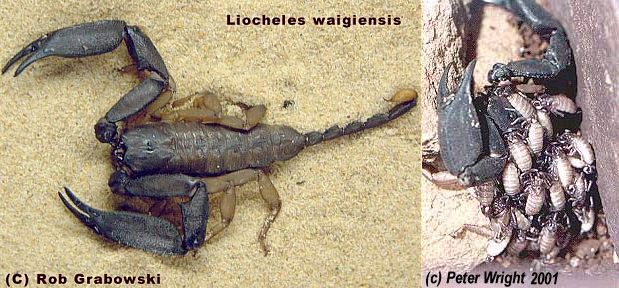|
- the Spiral Burrow Library -
Liocheles waigiensis
This scorpion belongs to the family Ischnuridae and generally occupies Queensland rainforests east of the Great Divide. There are also records of this species being found in Northern Territory and Western Australia, but only in northern coastal situations. Generally a rainforest dweller living amongst rotting logs or hiding in tight rock crevices. Some dryer scrubland adapted forms occupy a scrape under a rock. In association with the scrape there may be a short almost vertical burow. This observation may suggest the species has diverged with the drying of the continent.
Parthenogenesis, or reproduction from unfertilised eggs, is known to occur in 8 species worldwide out of a possible 1600 or more, (Lourenšo & Cuellar, 1995). The known parthenogenetic species are Tityus uruguayensis Borelli from Uruguay and Brazil, Tityus columbianus (Thorell) from Colombia, Hottentota hottentota (Fabricius) from West Africa, Tityus trivittatus Kraepelin from Argentina, Liocheles australasiae (Fabricius) from the South Pacific, Ananteris coineaui Lourenšo from French Guyana, and Tityus metuendus Pocock from Peru and Brazil (Lourenšo & Cuellar, 1995). Tityus serrulatus and Liocheles australasiae (Makioka and Koike, 1985). Liocheles australasiae is known to occur in the coastal rainforest of Far North Queensland and a few islands of the coast of the northern tip of Cape York. No valid reports of males exist for Tityus serrulatus (Polis, 1990). Koch, 1977 examined 90 specimens of L. australasiae stored in the Western Australian Museum and found only 3 males and 87 females. This does not indicate a true sex ratio as these specimens came from various localities throughout the Australo-Paupan region. Makioka and Koike, 1985, obtained 569 live specimens of L australasiae from two localities in Asia: the Cameron Highlands, southern Malay Peninsula, west Malaysia; and Iriomote Island, one of the Ryukyu Islands, Japan. Among the specimens no individuals could be found with the described male characteristics of L australasiae. On dissection, most of the larger individuals exhibited swollen ovarian diverticula containing embryos. Such pregnant females had about 20 swollen ovarian diverticula and a large number of egg-stalks bearing oocytes. Some pregnant females also showed empty ovarian diverticula, presumably from past parturitions. Other larger females had only empty ovarian diverticula. The majority of larger specimens taken from any locality were either pregnant or inter-pregnant. Immature females had neither ovarian diverticula nor egg-stalks (pedicels), but rather a large number of young oocytes held in the walls of the ovariuterine tubes. In the remainder that had the thread-like rudimental gonads filled with a great number of undifferentiated germ cells, the sex was indistinguishable. No individuals had distinct male gonads and no spermatozoa could be detected in any region of the female reproductive systems. From the studies it was concluded that there are naturally maleless populations of L. australasiae. Thelytokous parthenogenesis is not rare in the animal world (Makioka and Koike, 1985), although no such finding has ever been recorded in scorpions before. Further to the above research Makioka, 1992 managed to show through laboratory raised Liocheles australasiae that virgin females were capable of producing offspring. About 20 eggs began to develop simultaneously in the ovary several days after the final moult to sexual maturity. Juveniles were born about 8 months later. Several days after the first parturition, embryos again occurred in newly growing ovarian diverticula. A third pregnancy followed the second parturition. The ovary in the third pregnancy had newly growing ovarian diverticula, and a number of stalked oocytes of various sizes. These oocytes presumably indicated further repetition of pregnancies. The scorpions in this study could not have been self-fertilising hermaphrodites as no trace of sperm or other male elements were found throughout the reproductive tract. Consequently the females must have conceived without male gametes. It was also found impossible for the young to be produced asexually, as a number of stalked oocytes were present in the ovaries which give rise to the swollen ovarian diverticula. Features section
|

